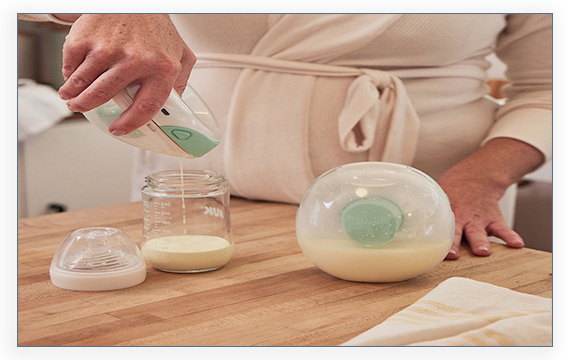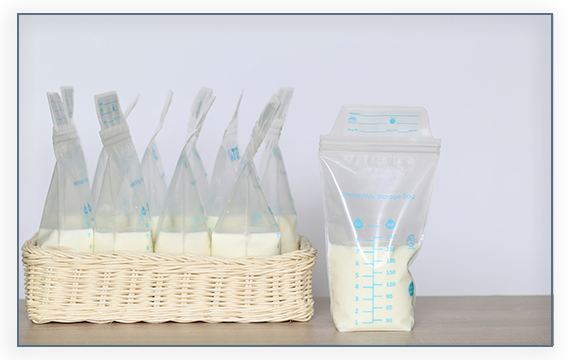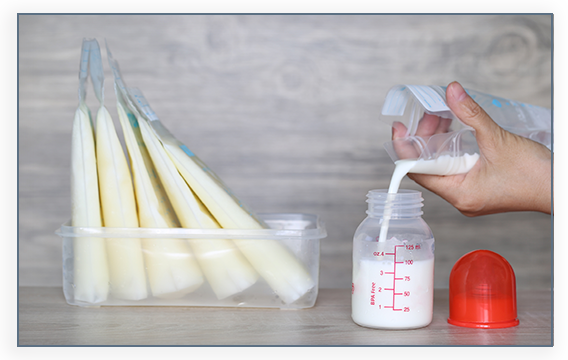Breastfeeding Basics
Expect breastfeeding to be a learning process. You and your baby are both learning; your baby is learning how to latch, suck, and swallow and you are learning your baby’s hunger cues, positioning for a proper latch, and managing your breast milk supply.

Getting started with breastfeeding
• After birth: Breastfeeding should be initiated within the first hour after birth. Practice skin-to-skin contact with your baby; your naked baby should be placed on your bare chest, as this will help get breastfeeding started. Skin-to-skin contact helps baby maintain an appropriate body temperature and begin to seek your breast. Newborns should nurse 8 or more times every 24 hours.
• First days: At first, you produce a thick, rich, yellow substance called colostrum. This is packed with antibodies, nutrition, and important substances your baby needs. It gives baby early protection against disease, is easy for him/her to digest, and is made in small quantities. He/she will likely get anywhere from a few drops, to 5 ml (one teaspoon) of colostrum at each feeding. The small amount your baby gets at first will teach him/her how to safely coordinate swallowing and breathing while suckling. As your baby learns to suckle and extract colostrum, his/her suckling tells your body to make more colostrum. Most babies will get all the nutrition they need through colostrum during the first few days of life.
Have more questions? Listen to our FREE podcast!
LISTEN NOWWhat’s next?
Over the next several days to two weeks, the colostrum will gradually transition to milk. You’ll be able to tell the transition is occurring, because the fluid will change from a yellow/orange color to a more white/blue color as your baby eats more and your body begins producing more milk and less colostrum. For most, this thinner, whiter form of milk comes in about 3 days after birth, but may take longer for first-time moms. When this occurs, you may notice your breasts feeling full, hard, and warm. Baby may also to want to breastfeed more frequently during this time. If you are concerned about your milk coming in, talk to a lactation consultant or your doctor or nurse.
Establishing a milk supply & latch
• Your breast milk supply boils down to supply and demand. The more frequently you are feeding or pumping, the more often your body is getting the signal to create more milk. When your body releases hormones during a feeding, you are sent the signal to create more.
• Research shows that successful lactation depends on 8 or more nursing sessions (up to 12) in 24 hours, both day and night, throughout the first month. Establishing this pattern during the first few days will help you get off to a good start. If you aim to nurse every two hours during the day and every three hours at night, you will achieve the frequency needed to establish your milk supply.
• For baby to transfer milk efficiently and effectively, a proper latch is key. With a proper latch, breastfeeding should not be painful. Although sore nipples are common in the first few weeks, if they are cracked, damaged, or bleeding, you may need to speak with a lactation consultant for help with your latch.
Finding a comfortable feeding position
Adjusting the position to find the best fit for you and your baby can significantly improve breastfeeding pain and make the process successful and enjoyable.
• Position yourself comfortably with back support, pillows supporting your arms and baby, and your feet supported by a footrest.
• Position baby close to you, with baby’s hips flexed, so that he/she does not have to turn his/her head to reach your breast. Baby’s mouth and nose should be facing your nipple, with his/her body touching you.
• Support your breast with a “C” or “U” hold, and try not to hold your breast at the nipple, so baby can properly latch.
• Latch baby to breast, encourage baby to open his/her mouth wide, and pull baby close by supporting the back/neck so that the chin touches your breast first. Baby’s nose will be touching your breast and the chin should indent the lower portion of the breast.
The information contained here within is not intended to be a substitute for professional medical advice, diagnosis, or treatment. Always seek the advice of your physician or other qualified health provider with any questions you may have regarding a medical condition. Never disregard professional medical advice or delay in seeking it because of something you have read. If you think you may have a medical emergency, call your doctor, go to the emergency department, or call 911 immediately. Edwards Health Care Services (EHCS) does not recommend or endorse any specific tests, physicians, products, procedures, opinions, or other information that may be mentioned here within. Reliance on any information provided by EHCS, EHCS employees, contracted writers, or medical professionals presenting content for publication here within is solely at your own risk.
Sources:
• https://www.cdc.gov/nutrition/infantandtoddlernutrition/breastfeeding/what-to-expect.html
• https://www.womenshealth.gov/breastfeeding/learning-breastfeed/making-breastmilk
• https://www.llli.org/breastfeeding-info/frequency-feeding-frequently-asked-questions-faqs/
• https://www.llli.org/breastfeeding-info/positioning/
• https://americanpregnancy.org/breastfeeding/latch/
Tags: Baby, Breast milk, Breastfeeding, Infant, Latch, Newborn, Tips, Tricks




